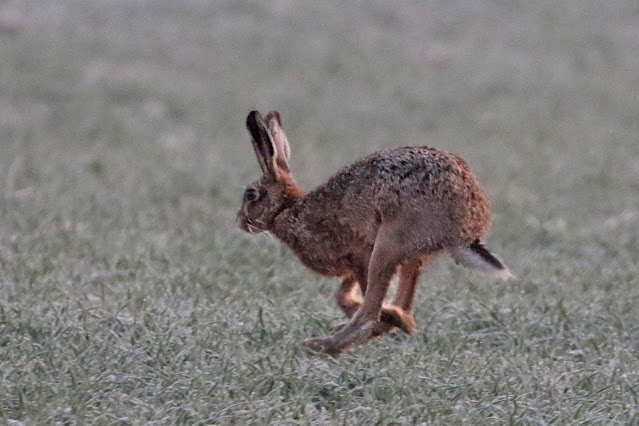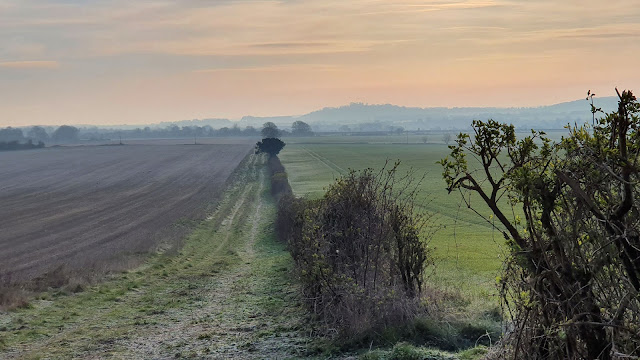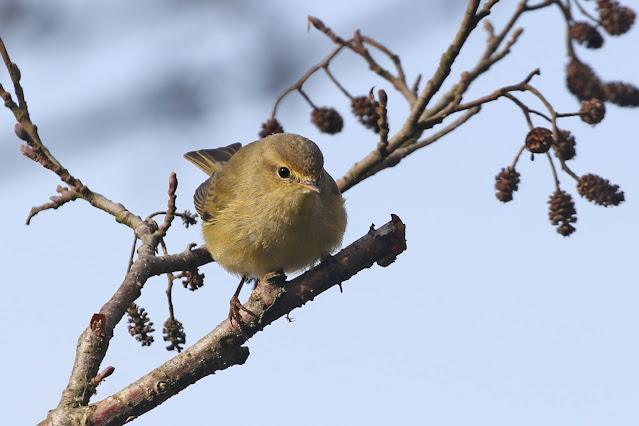Winter had returned, the warm sunny days of the end of March had given way to a biting north wind and heavy overnight frosts. I was meeting Ian at a location close to the Wiltshire border on the chalk downs. I arrived a little before sun rise and there was a frost covering the surrounding fields. The sky was orange as the sun was just below the horizon, you can also see the two dots of light from Ian's van as he was arriving.
Out in the middle of the field was a Brown Hare, silhouetted against the frost covered crops in the field.
The sun turning the background to the distant winter trees a lovely golden orange.
It quickly became apparent that there was more than one Hare in the field and one appeared from alongside the fence and hedge and kept coming towards us.
Stopping to ensure all was well.
As it kept ambling towards us it became clear that its breath had frozen in droplets on its whiskers producing a Mexican drooping moustache.
Finally acknowledging we were there it turned and this time ran away from us, back into the safety of the middle of the field.
It was a good start to the morning and we set off from the cars with a good feeling, which was unfortunately dashed a little as we came out of the tree lined path to the open fields. We were here for a Hampshire specialty, the Stone Curlew. A visit at the same time last year had resulted in finding two birds hiding in a stubble field close to the footpath. The dashing of that good feeling was because the surrounding fields were absent any stubble and were all showing a short growth of cereal crops.
Scanning those fields we picked up a fox hunting. First the stalk
Then the pounce
But the outcome was nothing and it turned away and made its way across the field.
The sun was now up and warming up the cold air, the light was providing some lovely pastel colours across the sky and frost tipped grass of the horse paddocks.
We had heard them as we walked down the main footpath, but they were hidden amongst the trees and were competing with the Chiffchaffs, but turning on to the byway Corn Buntings could be both heard and seen seen singing from the bushes that line the path. The familiar jangling keys song so distinctive and so much a part of the landscape.
This one caught by the light of the rising sun
Groups of Roe Deer were out in the surrounding fields that were Ministry of Defence land
The cultivated fields had Rooks, Woodpigeon and Stock Dove all foraging in them. The rough stubbly ground we were looking for was much restricted this year with the best chance we had of finding a Stone Curlew being on the M.o.D. land. There are rectangular scrapes set aside for the curlews, but of course these were empty of any birds. Being crepuscular they were by now probably sat down and out of view, they don't really move to quickly so the only chance you have is picking out something that looks different. We couldn't see anything different.
The Corn Buntings though seemed to be everywhere, quite possibly the highest density of these farmland birds I have seen in Hampshire and quite frankly anywhere recently
The classic Corn Bunting Photograph.
The Roe Deer were still showing with this pair resting on the brow of the hill.
While some of the fields were showing a growth of crop, other fields had probably just been seed drilled and here there were large finch flocks. The majority of the birds were Linnets and they would fly back and forth from the field to the surrounding bushes.
In amongst the Linnets were several Yellowhammer, a first for the year.
Corn Buntings continued to sing from almost every vantage point, while the rising sun was producing an element of mist and haze which was adding to the beauty of the area.
We had met a runner earlier who in talking with him informed us he was the farmer at the top of the hill and if we wanted to walk through the strip of trees to view the fields, this is what we did but only managed to find more Roe Deer.
We were now resigning ourselves to the fact that we were probably not going to be able to find the Stone Curlew, the suitable areas were distant and quite large. With this in mind we decided to make our way back to the cars.
Skylark were all around but this lazy bird was singing from a small bush.
There was a patch of ground at the back of a tilled field. The area was scrubby and Ian pointed out some birds in the field beyond that turned out to be Red-legged Partridges. As I scanned along the hedge line where the field meets a free strip I noticed a blob just in front of the rough scrubby patch, moving a little away to the left I found a bird standing up, this time it was clear what it was a Stone Curlew and we had found a pair.
These were the best images we could get, we were looking into the sun at distance.
We moved to try and get closer but were not able to do so, but we had record shots and to be fair we were always going to struggle to better last year unless they appeared in front of us. We had the year tick.
Walking on there was a large flock of Fieldfare in the adjacent field, moving across the ground as if on an organised search.
Walking back towards the cars we were serenaded by Chiffchaff and Corn Bunting, the frost had gone out of the ground and what was a solid footpath was now slippery mud. Drinking a cup of tea a Kestrel hunted over the horse fields but there was no sign of the Brown Hares.
Next stop was to be Fishlake Meadows, always an opportunity here for a spring migrant surprise, but as we pulled up in the car park it was the Chiffchaff that was singing and also a sizeable flock of Long-tailed Tits that showed very well.
We headed out along the canal path with more Chiffchaff singing in the trees on either side of the canal. With no leaves on the trees this is always the best time to photograph these spring migrants
Stopping at the first view point we scanned for hirundine without any luck, below us in the reedmace was a pair of Stonechat, the female showing well in between the stems
Alarm calls from behind us turned our attention to the sky where a Sparrowhawk drifted over our heads.
A black and white scene from the first viewing area.
At the next view point a Wren loudly broadcasting its territory
One of the specialty here at Fishlake Meadows is the Cetti's Warbler and at this time of year they are showing well as they, like the Wren broadcast their presence with a series of explosive notes. Typically they stay hidden, but will appear more now than at any other time of the year, still this nird was insisting on staying in the cover.
We walked to the screens in the middle of the reserve. There was little going on, more Cetti's Warblers singing, Greylag Geese flying over calling loudly, but no hirundines at all and no raptors.
Walking back we came across the Cetti's Warbler again along the canal path, this time though it was prepared to show all.
So far today it has been all the "C"s singing, Corn Bunting Chiffchaff and Cetti's Warbler, but now it was time for the Wren to join in. This individual belting out a tune from just above us.
We walked around to the viewpoint just off the road. On the way we came across the first Speckled Wood of the year, taking in the warm rays of the sun in a sheltered spot on the path
From the viewpoint there were Herring, Lesser and Great Black-backed Gulls, of the ducks Pintail, Gadwall Teal and Tufted Duck and of course several Great-crested Grebes. Back at the car park it was time for lunch and a decision on the next location, after debate we opted for Testwood Lakes, not I must add one of our favourites, but a reserve we have not visited for some time, the last visit being November 2017!
Pulling into the car park at the visitor centre a pair of Roe Deer were out on the main meadow, we walked across the meadow and then into the reserve and towards the hides, the path way was sheltered and there was plenty of Blackthorn in flower, but no butterflies. What we did manage to see was this Dark-edged Bee Fly
From the Sand Martin Hide there were Wigeon and Teal dotted around the pool. A group of Black-headed Gulls were roosting on a shallow spit and were joined by a single Little Ringed Plover. It was quite distant and you can just make it our amongst the Black-headed Gulls here.
There are sandy gravel beds in place to attract the waders to nest. In addition there is also an electrified predator fence all the way around the scrape and this has been successful in keeping out foxes and a like and has seen breeding success increase over the last few years. The only main danger for the Lapwing, Oystercatcher and Little Ringed Plover comes from the air, but the Lapwing are very adept and fending off that danger. As Herring Gull or Lesser Black-backed Gulls came to close they were immediately repelled by the Lapwing, constantly mobbing and chasing away the gulls. Interestingly they were more than happy to accept the Black-headed Gulls.
We could see both Lapwing and Oystercatcher already it seems sitting on eggs.
There were also several Tufted Duck on the bank and in the water, I couldn't resist this one as it drifted into the reflected blue sky in the water.
When they weren't sitting on eggs or chasing Gulls away the Lapwing were feeding on the grass, this one showing off an impressive crest and beautiful glossy green plumage.
A dog Fox appeared at the back of the scrape on and off and then finally walked around the main lake, it looked as if it was on the prowl for something, probably having to keep a vixen who was looking after cubs. It flushed out a pair of Coot and ended up in the water.
Then took an interest in the place where earlier a pair of Great-crested Grebe had been nest building but I think was put off by having to cross the water.
Interestingly it made no attempt to venture near the electrified fence, it has probably had an encounter and didn't want to experience 9,000 volts once more.
We walked around to the screens that look out over the back of the scrape. we could see a pair of Little Ringed Plover from the hide and we hoped that they may be closer. As we waited for the plover to walk a little bit more closer a Snipe appeared from the long grass and walked across in front of us.
Eventually the Little Ringed Plover came close enough for more acceptable shots, at least in these you can see the yellow eye ring!
The pair together, this was the second pair we had seen making four in total
These Little ringed plover have been a breeding success over the last two years as a result of the predator fence and the hope is that this will continue in 2022.
It has been a pretty typical early April day, the time of year promises so much but the weather also has a role to play and today the cold north winds of the last few days have probably blocked any significant movement. Still we did well to find the Stone Curlew and there was some great views of many Corn Bunting. Lets not also forget the frosty Hare right at the start of the day









































































No comments:
Post a Comment